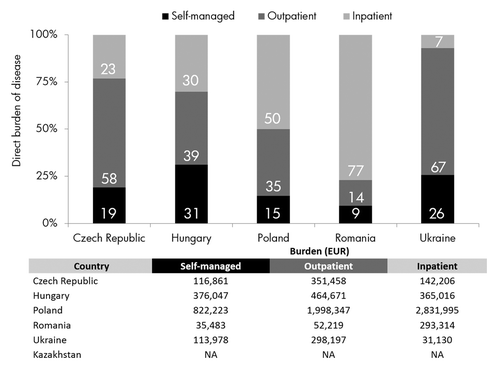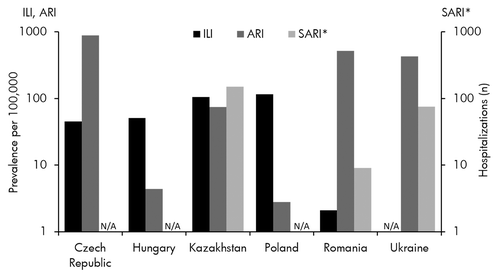Figures & data
Table 1. Vaccination coverage rate in the elderly (aged >65 y, except Hungary in the 2008–09 and 2009–10 seasons)
Table 2. Summary of healthcare systems in target countries
Table 3. Summary of results from the “Diagnostic Tool” completed by country experts
Table 4. Burden of influenza in the elderly by influenza health states (2010–11 season)
Figure 1. Relative healthcare burden in elderly patients per setting per country. Relative healthcare burden in Euro per setting varies considerably by country. Self-managed: influenza-like illness (ILI) and acute respiratory infection (ARI) patients that do not contact a healthcare professional; Outpatient: ILI and ARI patients that visit a healthcare professional or are referred to a GP after hospital discharge; Inpatient: Patients treated in a hospital (intensive care unit (ICU) or non-ICU) setting.

Figure 2. Influenza‐related infections and hospitalizations in target countries, week 15, Season 2011–12. Source: EuroFlu weekly bulletinCitation25. ILI, Influenza-like illness; ARI, Acute Respiratory Infection; SARI, Severe Acute Respiratory Infection; N/A, Not Available. *SARI values are estimates from EuroFlu graphs and are the count of hospitalizations in participating institutions.

Table 5. Summary of surveillance systems in target countries
Figure 3. Simplified influenza treatment algorithm used to model the disease burden. Health states in the model are mutually exclusive. Transitions between states are identified with an arrow, a solid line indicates a reversible transition and unidirectional movement is shown via a dotted line. Health states are classified as Outpatient or Inpatient as shown in in the “Setting” row. Cost items are summarized below the setting. The diagnoses considered to be influenza-related per health state are listed below the diagram. ILI, Influenza-like Illness; ARI, Acute Respiratory Infection; SARI, Severe Acute Respiratory Infections; OTC, Over The Counter; GP, General Practitioner; ICU, Intensive Care Unit.

